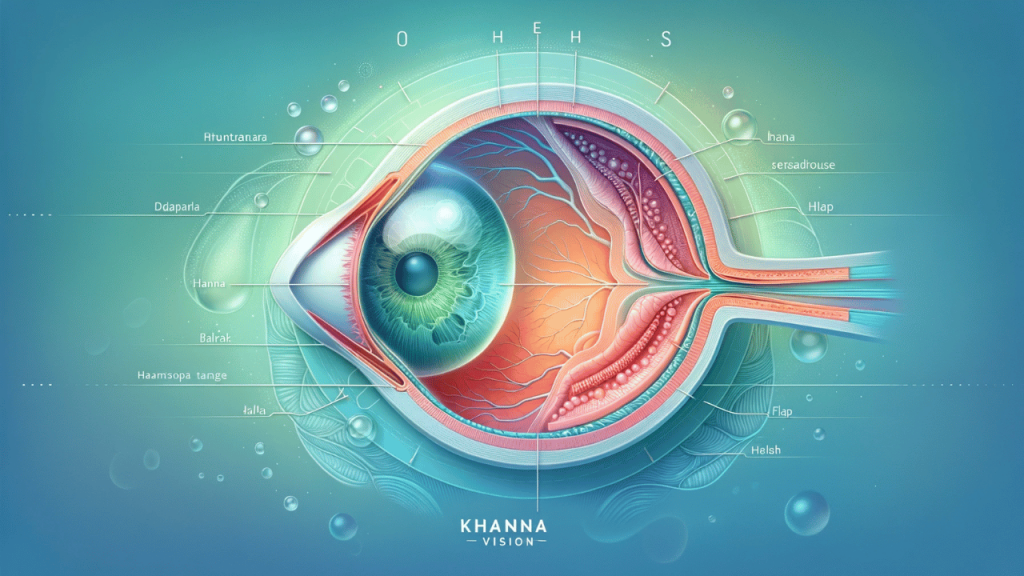Introduction
Laser-Assisted In Situ Keratomileusis, commonly known as LASIK, is a popular refractive surgery procedure aimed at correcting vision issues like myopia, hypermetropia, and astigmatism. A hallmark of the procedure involves creating a thin flap on the cornea, which is then lifted to allow laser reshaping of the underlying tissue. A frequently posed question about this surgery revolves around the healing process of this corneal flap. This article provides an in-depth look into the post-LASIK healing dynamics.

The LASIK Procedure: A Brief Overview
During LASIK surgery, a specialized instrument called a microkeratome or a femtosecond laser creates a hinged flap in the cornea’s outer layer. Once the flap is lifted, an excimer laser removes a precise amount of corneal tissue, correcting the refractive error. After the reshaping, the flap is repositioned over the treated area, acting as a natural bandage.
Flap Healing Dynamics
- Immediate Adherence: Once the flap is repositioned, it starts adhering almost immediately. Within minutes to hours, the flap sticks to the underlying stroma due to cellular and molecular mechanisms, and this initial adhesion prevents it from being accidentally displaced.
- Edge Healing: The healing process begins at the flap’s edges. Epithelial cells, which are the outermost cells of the cornea, start migrating to close the flap’s perimeter within 24 to 48 hours. This rapid edge sealing prevents contaminants from entering the interface area.
- Long-term Bonding: While the flap adheres quickly and the edges seal, the bond strengthens over time. Stromal cells begin to create new collagen fibers, leading to a more robust attachment. However, this bond, though strong, is never as robust as the original, untouched cornea.
Post-LASIK Care and Flap Complications
- Protective Measures: Post-surgery, patients are usually given protective eyewear to prevent accidental rubbing or trauma. Avoiding strenuous activities, especially those posing a risk to the eyes, is recommended for several weeks post-LASIK.
- Flap Displacement: Though rare, the flap can get dislodged due to trauma or excessive rubbing in the initial days after surgery. Immediate medical attention can usually reposition a displaced flap without long-term complications.
- Flap Wrinkles: Sometimes, microscopic wrinkles, known as striae, can form if the flap doesn’t settle smoothly. Minor striae that don’t affect vision may be left alone, while more significant or vision-impairing wrinkles might need surgical smoothing.
- Infections and Inflammations: While the flap edge heals rapidly, there’s a brief window where infections could occur. Adhering to post-operative medications, like antibiotic and anti-inflammatory eye drops, significantly reduces this risk.
- Epithelial Ingrowth: A rarer complication, this occurs when epithelial cells grow beneath the flap. Mild cases might not need intervention, but more pronounced ingrowths might require surgical cleaning.
Experts at institutions like the Khanna Vision Institute, under the guidance of Dr. Rajesh Khanna MD, emphasize the importance of post-operative care and regular follow-ups to ensure the best healing outcomes and promptly address any complications.
Conclusion
To answer the overarching question: Yes, the flap does heal after LASIK, but it’s a unique healing process. The immediate adherence and rapid edge healing ensure that the flap remains in place and the eyes are protected from contaminants. However, the bond, even though it strengthens over time, remains somewhat weaker than the original corneal integrity.
It’s imperative for patients to understand the intricacies of the healing process to ensure they take appropriate post-operative precautions. Regular follow-ups, especially during the initial weeks after the procedure, allow for monitoring the healing and early detection of potential complications.
Advancements in LASIK technology and techniques have made the procedure safer and more effective than ever. With renowned professionals like Dr. Rajesh Khanna MD leading the way, patients can be assured of not just vision correction but also comprehensive care that prioritizes their long-term eye health and well-being.